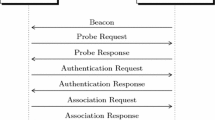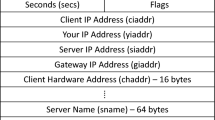Abstract
This paper investigates the effect of common network attacks on the performance, and security of several biometric readers. Experiments are conducted using Denial of Service attacks (DoSs) and the ARP cache poisoning attack. The experiments show that the tested biometric readers are vulnerable to DoS attacks, and their recognition performance is significantly affected after launching the attacks. However, the experiments show that the tested biometric readers are secure from the ARP cache poisoning attack. This work demonstrates that biometric readers are easy targets for malicious network users, lack basic security mechanisms, and are vulnerable to common attacks. The confidentiality, and integrity of the log files in the biometric readers, could be compromised with such attacks. It then becomes important to study these attacks in order to find flags that could aid in a network forensic investigation of a biometric device.
Access this chapter
Tax calculation will be finalised at checkout
Purchases are for personal use only
Preview
Unable to display preview. Download preview PDF.
Similar content being viewed by others
References
Vacca, J.: Biometric Technologies and Verification Systems. Butterworth-Heinemann Publisher, Butterworths (2007) ISBN-10: 0750679670
Wayman, J., Jain, A., Maltoni, D., Maio, D.: Biometric Systems: Technology Design and Performance Evaluation. Springer Publisher, Heidelberg (2004) ISBN-10: 1852335963
Chirillo, J., Blaul, S.: Implementing Biometric Security. Wiley Publisher, Chichester (2003) ISBN-10: 0764525026
Panasonic Iris reader BM-ET330, Specification Sheet, ftp://ftp.panasonic.com/pub/Panasonic/cctv/SpecSheets/BM-ET330.pdf
Nitgen Fingerprint reader NAC 3000, Specification Sheet, http://www.nitgen.com
Daugman, J.: Recognising Persons by Their Iris Patterns. In: Li, S.Z., Lai, J.-H., Tan, T., Feng, G.-C., Wang, Y. (eds.) SINOBIOMETRICS 2004. LNCS, vol. 3338, pp. 5–25. Springer, Heidelberg (2004)
The MIT Technology Review in the Emerging Technologies That Will Change the World, Ten emerging technologies that will change the world (January/February 2001), http://www.techreview.com
Duagman, J.: How Iris Recognition Works. IEEE Transactions on Circuits and Systems for Video Technology 14, 21–30 (2004)
Tony, M.: Biometric authentication in the real world, Centre for Mathematics and Scientific Computing, National Physical Laboratory, UK (Online) (2001), http://www.npl.co.uk/upload/pdf/biometrics_psrevho.pdf
Al-Raisi, A., Al-Khouri, A.: Iris Recognition and the Challenge of Homeland and Border Control Security in UAE. Journal of Telematics and Informatics 25, 117–132 (2008)
Trabelsi, Z., Shuaib, K.: A Novel Man-in-the-Middle Intrusion Detection Scheme for Switched LANs. The International Journal of Computers and Applications 3(3) (2008)
FrameIP Packet Generator, http://www.FrameIP.com
SYN flood, http://www.FrameIP.com
Al-Hemairy, M., Trabelsi, Z., Amin, S.: Sniffing Attacks Prevention/Detection Techniques in LAN networks & the effect on Biometric Technology. A thesis submitted to The British University in Dubai, School of Informatics (May 2010)
Author information
Authors and Affiliations
Editor information
Editors and Affiliations
Rights and permissions
Copyright information
© 2011 ICST Institute for Computer Science, Social Informatics and Telecommunications Engineering
About this paper
Cite this paper
Trabelsi, Z., Al-Hemairy, M., Baggili, I., Amin, S. (2011). Towards More Secure Biometric Readers for Effective Digital Forensic Investigation. In: Baggili, I. (eds) Digital Forensics and Cyber Crime. ICDF2C 2010. Lecture Notes of the Institute for Computer Sciences, Social Informatics and Telecommunications Engineering, vol 53. Springer, Berlin, Heidelberg. https://doi.org/10.1007/978-3-642-19513-6_6
Download citation
DOI: https://doi.org/10.1007/978-3-642-19513-6_6
Publisher Name: Springer, Berlin, Heidelberg
Print ISBN: 978-3-642-19512-9
Online ISBN: 978-3-642-19513-6
eBook Packages: Computer ScienceComputer Science (R0)




